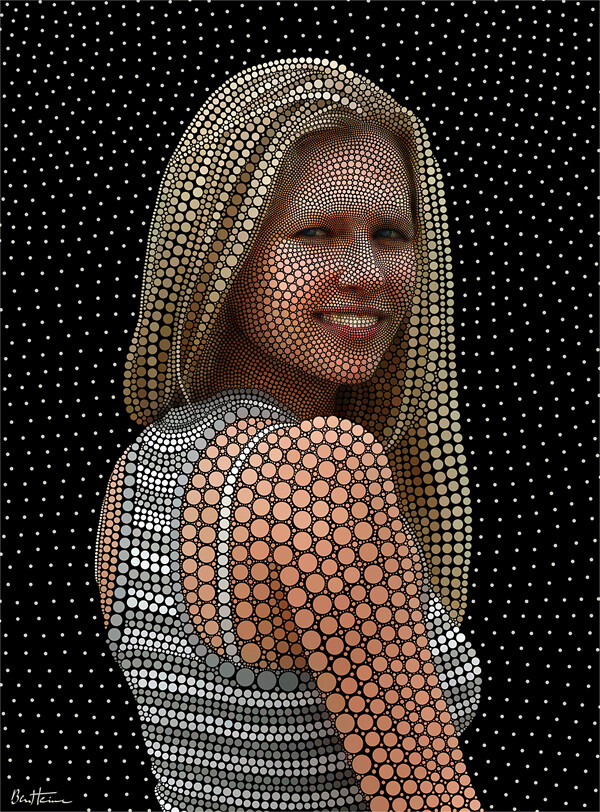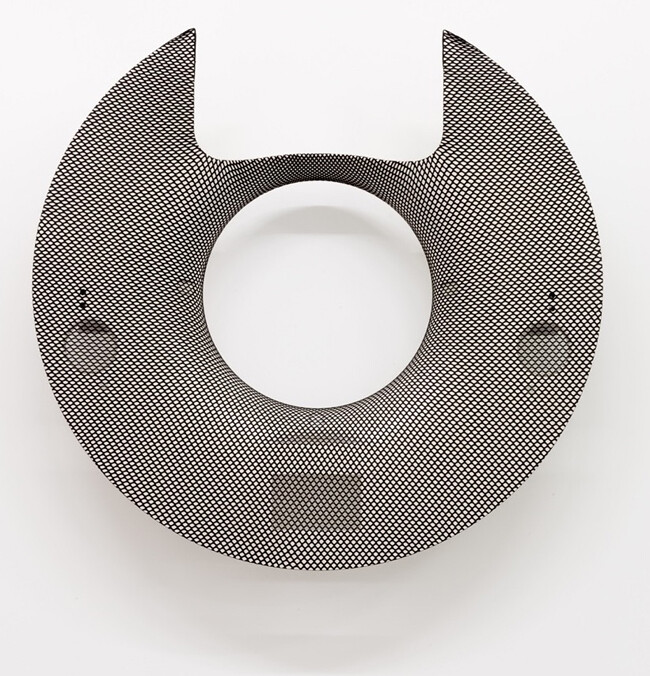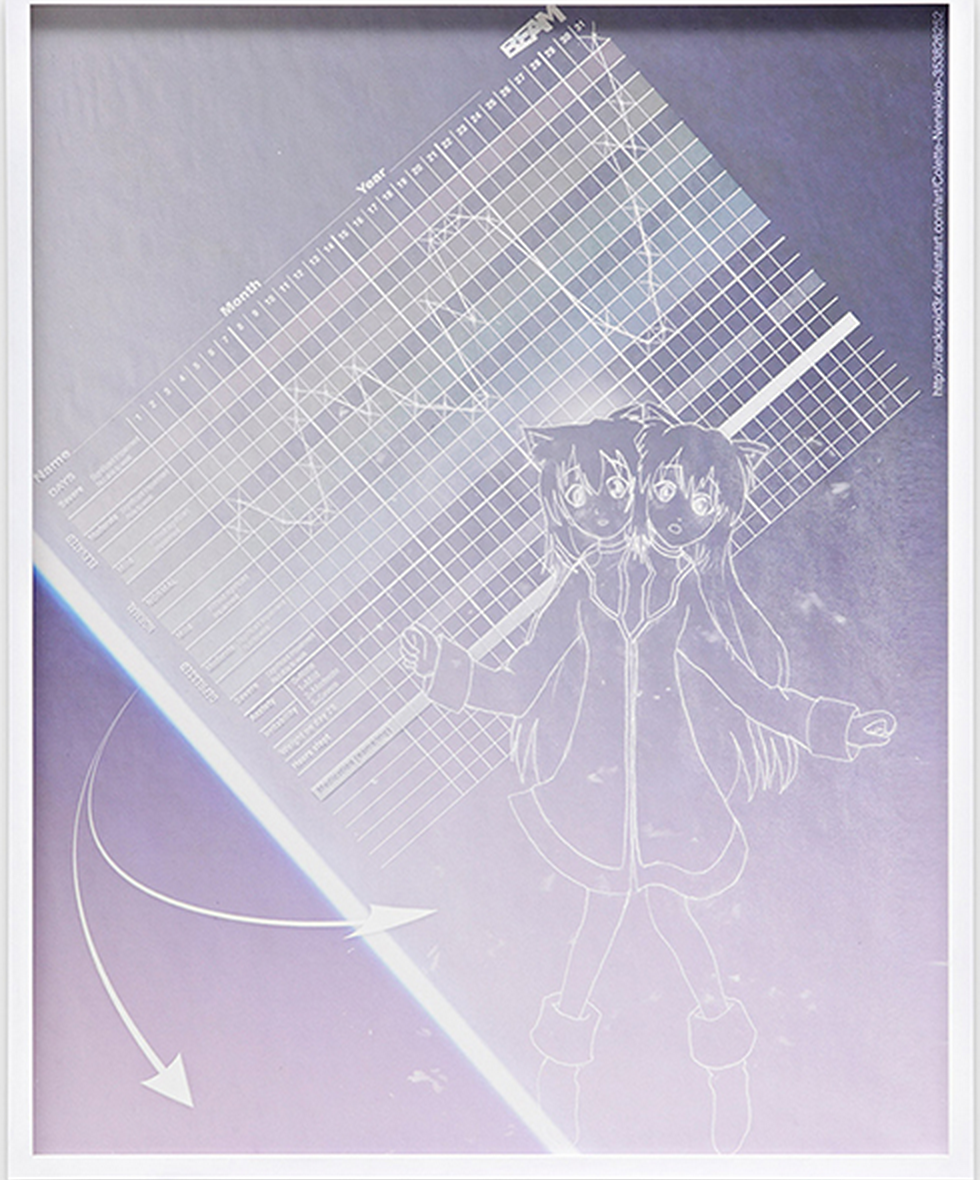Crowdsourced from DIS’s expanded network of collaborators, thinkers, and friends, here are our predictions for the 2020s.1
The 2020s begin on a high note. 3-D nano-printing pushes the greatest ever museological art displays into the public-private sphere of the living unit. Big art museums no longer expand, they merge with other museums, science centers, and in particular botanical and zoological gardens. The discussion surrounding the De-Extinction of Art reaches new heights when Mona Lisa is revived on her original organic support, a forever-warping poplar panel. Her aura, however, cannot be retrieved despite substantial crowdsourcing.2
The early part of the decade is lifestyle-dominated: the twee, up-cycled, bespoke, socially aware, artisanal life. Twice removed from the original source material, the first departure being the post-ironic referential mania of the turn of the twenty-first century. The second manifestation makes no attempt at authentic recreation. Instead, the content is self-conscious and wholly concerned with artifice (in the tradition of Lana Del Rey and Instagram filters). Sharing the sentiments of yesteryear’s steampunks, this hegemonic movement produces killer drones clad in Tuscan leather, driftwood, and yarn, and smartphones made out of distressed scrap metal and mass-produced Bohemian glass.3 The future is a season.4


Fortunately, the FTC modernizes the definition of antitrust to address both vertical and horizontal monopolies across markets, thus breaking up Google into three hundred companies. Commercial personalization gets its Snowden moment when a BlueKai data broker whistleblower outlines the extent of the industry’s manipulative, exploitative, and discriminatory targeting practices. Internet of Things companies form a self-regulating body and sign a common Code of Conduct charter outlining what they will not do with customers’ data.5
But by the mid-2020s a global crisis emerges marked by a shortfall in cocoa beans. This results in global riots, Nutella hoarding, and a conservation campaign that catalyzes innovative research in genetically modified chocolate and cultured cocoa. Meanwhile, all freshwater is privatized without a flicker of general outcry.6 Wars for water on water are waged and there is a furious return of Afrofuturism—intranet sun cults mesh with quantum-computed mycologies; artificial meat goes paramilitary while oceanic off-grid cultures send post-pop signals to ancient deities.7 The drought in California becomes so extreme that the state’s wealthiest citizens flee, leaving the working and poor behind in a bone-dry state to fight over drops of water.8 Global power tips toward Asia and climate change becomes an even bigger and sadder topic.9 From seasteading to spacesteading: tax havens move to outer space.10
Oil is worthless as a fuel source, transforming oil fields into playgrounds for kids and therapeutic spa resorts for the elderly—all thanks to a new full-body suit that shuts out its poisonous components and absorbs the beneficial petro-bio energy it exudes. Oil pools are remodeled into swimming pools, where synchronized swimming teams splash in wondrous formations.11 Nestlé takes over as the corporate municipality manager of the US, but needs to form massive labor camps to run its conversion systems. Soon it is discovered that Nestlé is actually using free labor to extract and distill water from living human bodies—feeding the water back to the massive labor pool that produced it.12


Our new props realize the microfascisms of fantasies past. Karlheinz Stockhausen dreamt of a “Sound Swallower,” for example, that could shoot negative wave patterns at the acoustical excrement in public space. This numbers among our counter-sensory tools, each enabling sufficient cancellation, obfuscation, and outright un-sensing for us to gain—in common yet apart—our own private island in waking life.13
After nearly six centuries of defiant self-assurance, soul-searching symposia, and interdisciplinary pilfering, architecture finally ceases to exist as a standalone professional career resulting from academic study. Building design is taken over entirely by graphic designers, who subsume much of the production of the plastic arts. Most “users” experience “space” through competing virtual reality platforms catered to the individuated interests of the surrogate self.14
Higher education shrinks as the next generation of funding crumbles under loan default. Over half of all universities close; this reveals universal higher education as an ideological formation of the post-Enlightenment state. Earnestness and autodidacticism are en vogue. It is not we who surround objects, but they who surround us.15
A cell of queer biohacker terrorists manage to infiltrate the processing plants of the most popular aloe vera water brand of the time. They taint millions of bottles with a custom “queering” retrovirus which increases the stochasticity of gender identity of embryos when pregnant women drink it. This leads to a sort of LGBTQI baby boom, influencing the cultural history of the mid-twenty-first century irrevocably.16
Emotions are now available for trade in the financial market.17 A constant stream of social output from any one person becomes rarefied, making social-binging the more common mode of output and intake.18 TMI is the best way to enjoy some privacy. Posting confusing information, over-posting, over-sharing, and over-tagging are used as strategies for diverting attention.19 The future does not exist but in snapshots.20 We no longer talk about privatization as a process—having lost any meaningful point of comparison—but merely as a quality, like heat or light, through which we claim to know the world.21 The differences between the social feed and the rubble pile dissolve as we regain an appreciation for fragments which do not add up to a total sum.22


Teenagers try to thwart each others’ fuckability ratings. All people have fuckablity, conversion-power, and baditude publicly displayed, hovering on them.23 For the wrong reasons, a game show in which the contestant is asked to react to a full upload of her entire internet history becomes popular. Her internet history is displayed bit by bit in different public scenarios and in intimate spaces with her friends, family, and coworkers. The supply of willing contestants is endless, the game inspiring pride in an entire generation’s shamelessness and code-switching skills.24
Current food trends and allergies such as milk, gluten, or even red grapes produce a new human. Humans are smaller but much more elastic––the result of less acid fats and carbohydrate consumption. This diet creates a body less easy to identify as male or female. Sex increasingly loses its physical performance character, instead becoming more involved in erotic interactions and the self-scenery of the body.25 The proliferation of smart sex toys is followed by an asexual revolution.26 Fashion … do people even wear clothes? In the 2020s, style isn’t cyclical: everything happens all at once and is all about texture.27 The future is layered and inconsistent.28
Bars and restaurants are replaced by lounges where different forms of exercise are naturally performed. Work or walk, move or write, dictate or talk as a form of reading … new forms of movement replace the old habits of sitting in bars or restaurants.29 Parties are hive-like, one-mind gnostic experiences, but engineered and trend-enslaved.30 Yesterday’s Xanax, drinking, shiatsu, and serotonin injections have been replaced by a much more sophisticated apparatus that we plug into, making us feel perfect.31 The future is overrated.32


The demystification of finance and the burgeoning DIY software development culture produce a new power elite: teenage financiers who are always at least ten steps ahead of fruitless attempts to regulate the mainstreaming of finance online. These teenage financiers advise contemporary artists on fiscal strategy. This leads to a seismic shift out of contemporary art’s past socioeconomic ecology and into one where the gallery system is forced to rapidly reform. Collectors get cold feet and flood the market with unwanted artworks. Having foreseen this turn, teenage financiers and their artist/curator clients cash in on the art market’s fall in value. With the end of contemporary art and the deflation of the transnational exhibition format as a driver of value, grounds previously occupied by biennials are given over to the Global Housing Authority for Displaced Populations, while the Cloud Biennial becomes the publicly accessible dedicated archive for the contemporary art era.33 Then a wiki battle breaks out. What is at stake is the last job left that no bot can manage.34 The future is what we construct from what we remember of the past—the present is the time of instantaneous revelation.35
The future is widely reproduced and distributed.36 Performance is popularized as interior decor.37 Appropriation is illegal. Artworks with identifiable references, monitored by apps, are relegated to the category of “entertainment.” All degrees become obsolete except for curation, which is taught in primary school; a trend in child curators bolsters a surge in crafts-based art and pottery. Curation becomes the highest art form and artists must become publicists for curators in order to survive.38
The future is waiting—the future will be self-organized.39 Culture finally liberates itself from its tendency to resort to modernist categorization, and operates cross-sectionally and globally between communities (virtual and physical). The infamous “gap” between art and life closes after over a century of separation. There are no more “artists,” “interior designers,” or “PR agents,” there are simply operators within culture.40
Everything is legal and nothing is taboo, so why bother? With freedom from want, all that’s left for human beings to do is tag photos, comment on videos, and aggregate content. At night we gaze into the screens of our holophones, pushing colored squares back and forth and up and down, nullifying any hint of resistance. The benevolent overlords endlessly pipe the song “Happy” by Sir Pharrell Williams into our dwelling units, and it works … we are happy. But there is still an underground. The bohemians, outsiders, renegades, dreamers. The fringe of society thrives.41 They buy “unfollows” to retain cult status.42 They sing and swear and make candleholders out of vintage cameras. They live in tiny prefabricated houses on the peaks of the Landfill Mountain Range, just past the civilized world, mining its detritus for material to use in their assemblage sculptures. The Underground’s armies of improv comedy troupes attack the colonies with vicious satire, hammering at the walls of hypocrisy. Yes, their critiques are hard-hitting, but they unknowingly provide Neo-America with the only resource left on earth … raw content.43


Everyone in the world receives a stipend of one thousand dollars a month regardless of income.44 People don’t go to work or have jobs. The desire to rank high on the efficiency scale is considered an expression of sorrow, narcissism, blurred identities, and escapism.45 They spend most of the day giving each other orgasms while wearing hats that look like furry Kangols with little projectors inside. Those who give the most orgasms are promoted to Orgasm Manager, and then Pleasure President.46 The internet feels more and more awkward, desolated, a socialist hotel ruin on a Croatian beachside in the ’90s, spam infrastructure and nobody to play with.47
A diary excerpt from 2027: I open my e-mail and quickly vote on the twenty laws sponsored by the groups I subscribe to. Since they abolished representational government I’ve gotten used to the wake and vote routine. It’s my week as a senator for New Staedt and I hurry to the hotel to check in. I feel a responsibility to my three hundred employees, who occupy three of the largest floors of the Dong Feng-Sachs Tower, to make a physical appearance in the studio every day. Otherwise, I think, pulling on one leg and then the other of the transparent nylon, lightly tanned skin barely visible, what kind of artist would I be?48 Dum spiro, spero—while I breathe, I hope.49
Okay, okay, I’ll tell you about the future; but I am very busy right now; give me a couple of days more to finish some things and I’ll get back to you.50
The reality of the future is that it looks a lot like the past. Luckily, an extremely intelligent modernized version of the Tamagotchi replaces human life completely as we approach 2030. Yes, there are more natural disasters, more gender-transitioning celebrity offspring, and the usual talking about but absence of actual space exploration.51 Luddite terrorism is on the rise, for example: natural-body terrorists blow up smart-suit and brain-machine-interface businesses.52 All we can really hope for is some good designer drugs that actually wake us up from the matrix.53
Sure, our nipples could be penises, surrounded by broods of temporary eyes forming and unforming as planets of light. We ooze across the crust as a swarm, a vast sheet of furry protein, and then erect ourselves inside microfiber pantsuits for the promenade.
Arranged one way, we are a ripe strawberry, arranged in another, we are the reanimated grandpa of someone who wants to understand the past. This grandpa will be fog, and then bacteria, the age of which we will never escape. We have shapes—a thousand shapes beyond all memory. Shapes in motion, or shapeless congeries of particles, from which we depart—travelling at the speed of light, as waves of self patterns, with the option to land softly back into our meats.54
Red Pill, Neoreactionary, MRA, and PUA ideologies coalesce into a New Right. Hyperstitional immanentization of idyllic pastoral patriarchal pasts through mass fantasy and sci-fi narratives (example: Game of Thrones).55 Anthropocene and Heard. FOGO clubs. Airbnb-sponsored Welfare State. Better space for all. Smart Poetry.56 Queer Domination. Skype Chapels.57 Since the origin’s origin, life precedes death, wherefrom the future.58
Soothing serotonin match hookup every Friday night following collaborateur design embarrassment. Genocide experience camps, P=NP polyniminal ugh no. Google as a shot glass. Grassroots-forced local compliance notifications abundance, when in roam we are roaming hard, international network clearance assigning agency. Access for the poor. Procrastinacore avalanche on hold, kept going. Much needs to occur, however, between the collection of data and observations, the extraction of parallel material from the existing record, and the final insertion of new material into the general body of the common record.59
Future? … you must be mistaken.60 Död fisk.61 More blood at one end, more Gilded Age at another. Monkeys with car keys.62
The format and title of this piece is based on Pedro Almodovar’s essay “Styles and Customs in the Nineties,” The Patty Diphusa Stories and Other Writings (New York: Faber, 1992) →. See also Tyra Banks’s predictions → and Kevin Kelly and Brian Eno’s Unthinkable Futures →. We suggest using Fortunately/Finally/But/However/Although to start your own predictions. For earlier predictions, see DIS & Patrik Sandberg, “Styles and Customs in the Twenty-Teens,” DIS Magazine, April 26, 2010. See →
Toke Lykkeberg
Khalid al Gharaballi
Pierre Huyghe, Curated by Hans Ulrich Obrist
Sara M. Watson
Barrak Alzaid
Tue Greenfort and Julia Moritz
Chris Kasper
Timur Si-Qin
Marvin Jordan
Monira Al Qadiri
Chris Kasper
Tyler Coburn
Shawn Maximo
Mike Pepi
Daniel Keller
Agatha Wara
Natasha Stagg
Amalia Ulman
Philippe Parreno, Curated by Hans Ulrich Obrist
Agatha Wara
Jon Lucas
Nik Kosmas
Natasha Stagg
Chus Martinez
Marvin Jordan
K-Rizz
Liam Gillick, Curated by Hans Ulrich Obrist
Chus Martinez
Nik Kosmas
Dora Budor
Cerith Wyn Evans, Curated by Hans Ulrich Obrist
Victoria Ivanova
Toke Lykkeberg
Lawrence Weiner, Curated by Hans Ulrich Obrist
Cory Doctorow, Curated by Hans Ulrich Obrist
David Toro
Ada O’Higgins
Raqs Media Collective, Curated by Hans Ulrich Obrist
Jeppe Ugelvig
Nick DeMarco
Marvin Jordan
Nick DeMarco
Body By Body
Maja Cule
Body By Body
Maja Cule
David Andrew Tasman
Nancy Spero, Curated by Hans Ulrich Obrist
Jimmie Durham, Curated by Hans Ulrich Obrist
Analisa Teachworth
Nik Kosmas
Analisa Teachworth
Andrew Norman Wilson and Jane Long
Andrea Crespo
Note from Alessandro Bava: (CC Harry Burke)
Alessandro Bava
Etel Adnan, Curated by Hans Ulrich Obrist
Constant Dullaart
Trisha Donnelly, Curated by Hans Ulrich Obrist
Marie Karlberg (translation from Swedish: dead fish)
Gayatri Spivak

